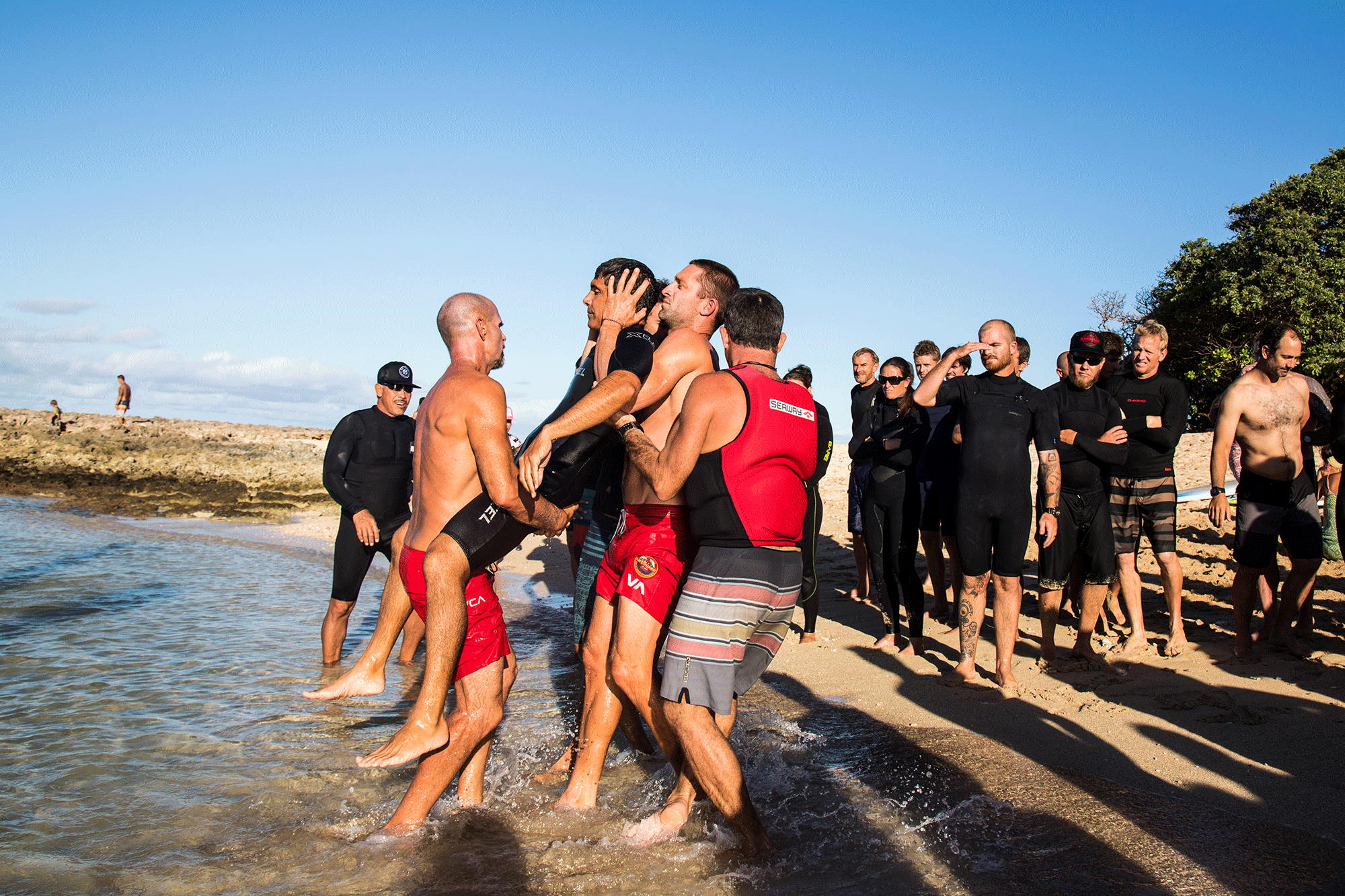If you were out in the lineup and another surfer found themselves in an emergency situation, would you be able to help them? While we may consider surfing in most conditions to be a relatively safe endeavor, emergency situations can arise on even the most mundane swells—people get bulldozed by boards, slam their faces into the reef and worse. And the unsettling truth is that most surfers are not nearly as prepared to deal with those situations as they think they are.
Brian Keaulana, legendary lifeguard, big-wave surfer, stuntman and all-around waterman/badass aims to help surfers to be more prepared when crises happen. That’s why he—along with Kohl Christensen, Danilo Couto and Pat Chong Tim—created the Big Wave Risk Assessment Group, which aims to teach surfers how to mitigate risk in the ocean and what steps to take when the unexpected occurs. As the name suggests, the group holds certain courses on big-wave safety training and rescue—but their summits are also open to surfers of all skill levels and cover a broad range of topics.
As the Chief Master Instructor, Keaulana teaches surfers basic CPR training, worst-case scenario analyses and basic breath-holding techniques. “With all the manuals and the risk management that I teach, this gave me a platform to now teach surfers how to create safety where safety doesn’t exist,” Kealuana told me over the phone. For an in-depth education on water safety, you should definitely sign up for one of Kealauna’s courses, but in the meantime, here are his six tips from Kealauna for everyday surfers to be more prepared for emergency situations in the lineup.
KNOW YOUR LOCAL EMERGENCY NUMBERS
“Every surfer should know that there are processes already in place to help you. If you can only do so much physically, you need trained professionals to come in and help. When you travel around the world, research local emergency numbers. In Europe, it’s 112. If you come to the US, the emergency number is 911. Most surfers don’t preplan—they’re just free people. It also depends on how remote you are going to be. And what, if something does happen, is the time of response to the time of actual help? If there’s no help, how can you help yourself and your friends? Do you carry your own medical gear if something comes up? Do you know how to use a tourniquet? It all stems from developing your plan—if you have the greatest time and nothing happens, then great, but if something does happen at least you have a plan to set into action.”
GET TRAVEL INSURANCE
“When you’re traveling, look ahead and get medical travel insurance. What if you break your back or neck and you’re stuck in a foreign country—what do you do? Travel insurance is different than travel medical insurance—it’s cheaper and it’s specific to medical issues. Another good option is getting diver’s insurance as well. Mike Prickett [surf cinematographer] went down to rescue someone [in Tahiti] and got the bends and he ended up getting paralyzed. But that insurance covered his helicopter evacuation to the hospital—it covered everything.”
DEVELOP A VISUAL OR AUDIO CUE FOR HELP
“Communication is key above all. Lifting up your board and waving it back and forth is a good long-distance visual sign of someone calling for help–that there’s an emergency happening out in the lineup.”
LEARN CPR
“Any knowledge that you have in first responding is crucial—and that’s what BWRAG is good for. It’s a risk management class. We also point out other further classes you can take, like lifesaving classes or survival classes in the ocean. But I would say that CPR is something everyone should know how to do. Even my 3-year-old niece knows CPR.”
DON’T MOVE SOMEONE WITH A POSSIBLE NECK INJURY UNLESS ABSOLUTELY NECESSARY
“Dealing with a neck injury is one of the highest concerns, because if you move someone with a spinal injury the wrong way they can die or you can further injure them. Knowing any kind of spinal training is helpful. We train in spinal extrication all the time. But it’s not a situation where you take one class and know everything you’ll ever need to know. Lifesaving is like surfing—you only get better through practicing. But if you’re dealing with a spinal injury and you’re not trained, always remember to try not to move the person. Minimize the movement unless you really have to—a car is exploding, a shark is coming or some other imminent danger.”
IF YOU NEED TO RESCUE A DROWNING VICTIM, PUT A BARRIER BETWEEN THE TWO OF YOU
“It’s common when you find yourself in a situation where someone is drowning or struggling, and you try to help, they will try to grab you and pull you down inadvertently. You should always try to give them some sort of flotation device—like a surfboard—or give them distance. You don’t want to escalate the situation from bad to worse and you become the victim too. After that, it’s really just about calming them down because they are in panic mode. If you’re excited, they will get excited. Talk really slowly and calmly—create calm inside of chaos.”
If you’d like to find out more, visit the BWRAG site
[Editor’s Note: This article was originally published in 2019]
Original Post from this site

